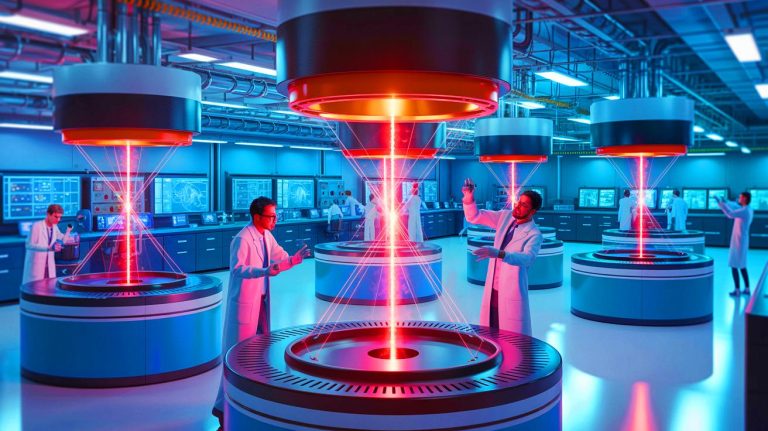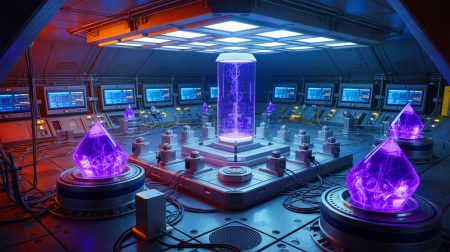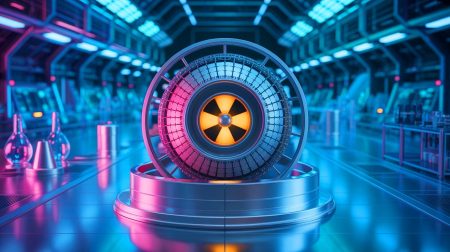| IN A NUTSHELL |
|
In a groundbreaking experiment, an international research team has successfully produced hydrogen-6 (⁶H), one of the most neutron-rich isotopes known. By utilizing the Mainz Microtron (MAMI) particle accelerator, researchers have developed a revolutionary technique for studying exotic nuclei through electron scattering. This achievement marks a significant milestone in nuclear physics, challenging existing theories about multi-nucleon interactions. The findings suggest that the interactions between neutrons in extremely unstable nuclei are stronger than previously thought, prompting a reevaluation of these forces in neutron-rich environments. The experiment was a collaborative effort involving scientists from various prestigious institutions.
Hydrogen-6: One of the Furthest Reaches of Nuclear Stability
Hydrogen-6, comprised of a single proton and five neutrons, represents a boundary of nuclear stability. As the isotope with one of the highest neutron-to-proton ratios known, it pushes the limits of what is understood about atomic nuclei. Understanding such exotic isotopes is crucial for answering fundamental questions about nuclear interactions and stability. However, experimental data on these isotopes are scarce, leading to debates about characteristics such as the ground-state energy of ⁶H. The recent findings from the MAMI experiment provide new insights into these nuclear properties, suggesting that the ground-state energy is lower than many theoretical predictions, thus challenging previous assumptions about neutron interactions.
Employing a Two-Step Process
The research team at MAMI employed an innovative two-step process to produce ⁶H. By firing an 855 MeV electron beam at a specially prepared lithium-7 (⁷Li) target, they initiated a sequence of interactions. First, the electron beam excited a proton within the lithium nucleus, causing it to decay into a neutron and a pion. This neutron could then transfer its energy to another proton, forming the neutron-rich hydrogen isotope ⁶H. The detection of this rare isotope required the simultaneous measurement of the scattered electron, the ejected pion, and the ejected proton using three magnetic spectrometers. This complex setup enabled the identification of ⁶H amidst a challenging experimental environment.
Combining Electron Beam and High-Resolution Spectrometers
The success of this experiment hinged on the unique combination of the high-quality MAMI electron beam and the high-resolution spectrometers of the A1 Collaboration. As Professor Josef Pochodzalla from Johannes Gutenberg University Mainz (JGU) noted, this setup was crucial in overcoming technical challenges. The experiment utilized an elongated lithium target, measuring approximately 1.77 inches long and 0.03 inches thick, to maximize interaction probability. Despite the technical difficulties and the rarity of the process, which yielded about one ⁶H event per day over a four-week period, the precision and low background noise of the setup provided a clear signal. This confirmed not only the production of the isotope but also its unexpectedly low energy state.
Implications and Future Directions
The production of hydrogen-6 using this novel technique offers profound implications for our understanding of nuclear physics. By revealing a lower-than-expected ground-state energy for ⁶H, the experiment suggests that current models of nuclear interactions may need revision. This opens new avenues for research into multi-nucleon forces in neutron-rich environments, which could have implications for both theoretical studies and practical applications in nuclear technology. The collaboration across international institutions also highlights the importance of global scientific partnerships in advancing our knowledge of fundamental physics.
As the researchers continue to explore the properties of hydrogen-6 and other exotic isotopes, new questions arise about the nature of nuclear stability and the forces that govern atomic nuclei. How will these findings influence future research in nuclear physics, and what other unexpected discoveries await in the realm of exotic isotopes?
Did you like it? 4.7/5 (23)










Wow, hydrogen-6 sounds like a sci-fi element! 🧪 Can it be used for anything practical or just research for now?